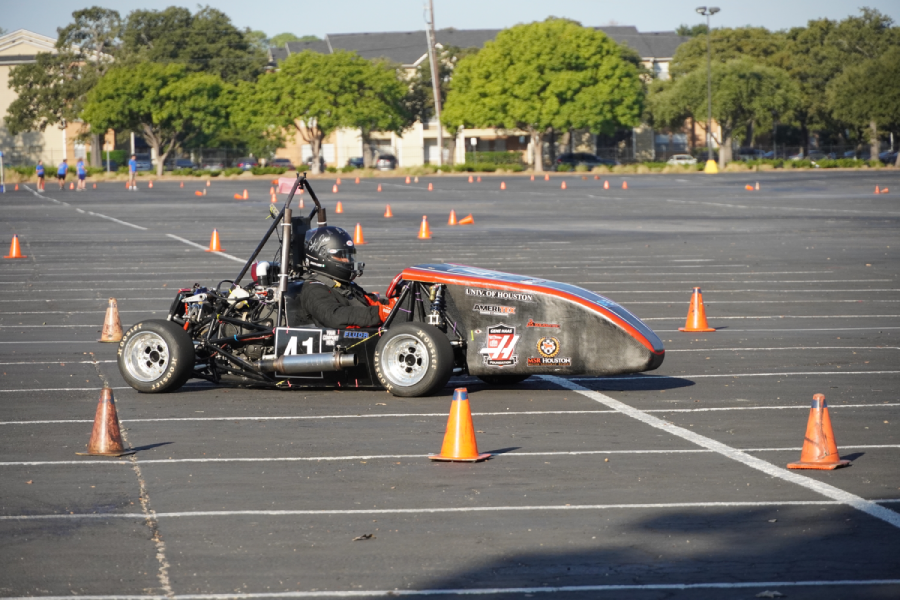Mechanical engineering junior Rasheed Korayem, director of communications, and mechanical engineering technology senior Rohit Amaravadi, vice president, know that first place isn’t won in a day. Texas Autocross Weekend 2024 wrapped up just last month, and the Society of Automotive Engineers at UH is already looking forward to Cougar Racing’s success in 2025 and 2026.
Established in 2015, the student chapter of the Society of Automotive Engineers (SAE) at University of Houston “aims to make UH competitive within Formula SAE” – a design competition that challenges students to conceive, design, fabricate, and compete with small formula-style racing cars. UH student members are “provided with both technical and teamwork experience by working together to design, build and compete with a Formula-style open-wheel race car.”
Texas Autocross Weekend 2024 marked the first official event in which the team has competed with their most recently built vehicle.
“We haven’t had a car built in about four years – since COVID started – and we have spent this time designing, manufacturing, and finally testing. The UTA Autocross event was us finally putting our car through its paces,” said Korayem. “Given all of that, it was definitely a success. We placed somewhere around 39 out of 59 cars – right in the middle of the pack. Considering that this was our first car in a long time and our current members’ lack of previous competition experience, I’d say that was a pretty big success.”
“Anybody familiar with motorsports knows just how ridiculously expensive of a sport it is,” added Amaravadi, “and that definitely applies to FSAE and this competition.”
Amaravadi characterized many of the teams UH competes with as “generational teams”: teams that are designing, manufacturing, and bringing a new car to competition year after year, back-to-back, with significant industry support. Teams are indeed expected to bring a new chassis to competition each year, often with a different set of objectives to match: one year a team may focus on acceleration, the next on braking, and after that perhaps the fastest overall time.
“They may be spending upwards of $40,000 to $50,000, even $60,000, on these cars each year. Some teams spend upwards of $100,000. We built our car for under $10,000,” he said. But generational teams don’t just benefit from monetary industry support; they thrive on the transference of institutional knowledge and momentum.
“We had no transfer. We had no blueprint to go off of. That’s why we were very impressed with how well the car performed, even with the issues we had,” said Amaravadi.
He described the topic of sponsorships as a bit of a “chicken and egg” situation: “Sponsors want to see that the team they’re supporting is going to use that support effectively. They want to see that you have a car… but how do you build the car without the funding? When you’re dealing with that situation, it just takes that much longer to build your car. That’s why it’s taken us two years for our current build.”
It may be an expensive sport, but the organization’s value to its members can’t be understated. One of SAE at UH’s overarching goals for their members is to provide “real-world engineering experience.” Amaravadi cited real-world applications of classroom topics like thermodynamics, solid mechanics, statics, dynamics, and others as areas that student members gain valuable experience in over the course of building a Formula SAE car. “Learning how to validate a design is crucial in making good engineering decisions, and projects such as FSAE provide a great opportunity to learn these skills.”
“[For a lot of our members], we’re the first step into hands-on experience with things like machining and using power tools. Employers really like to see that, and it helps students avoid falling into the cycle of needing experiencing to get an internship, needing an internship to get experience… Student orgs like ours are where you can learn how engineering decisions are made and how to overcome common issues in the shop. We’re that first step into valuable, marketable experiences and skills that can apply towards internships and impress potential employers,” said Korayem.
“If you feel you lack the experience to participate, dive off the deep end and learn to swim. It’s a gradual learning process: join Cougar Racing and learn the skills that will not only develop you as a professional but also as an individual,” said organization president Patrick Sanchez.
Though students from related programs may benefit the most, Amaravadi and Korayem made clear that SAE at UH welcomes students from any major or program of study.
“A lot of [our members] who aren’t engineering or technology division students still have that passion for cars and motorsports that drives them to want to be part of the team, and even in leadership positions for our organization,” said Korayem, noting that one suspension sub team lead is double-majoring in biology and psychology and on a pre-med track.
Bhuvanesh “Ben” Jagasia, powertrain sub team lead, describes the diverse team as “a passionate group of dreamers and doers, with a bold vision, uniting to face a great challenge.”
“We all have a lot of pride in our school and in the city of Houston itself, as well as Texas, but beyond that, we want to turn our organization into a generational team. We have the passion. We have the interest. We have the know-how. We just need the continued experience and the sponsor support. Now that we have things rolling, that’s the legacy that this generation of leadership wants to leave behind: the tools and connections to keep having a car built year after year. We know that expanding to reach the level we want to reach will take a few generations of work, but we know we’ll be able to get there,” said Amaravadi.



